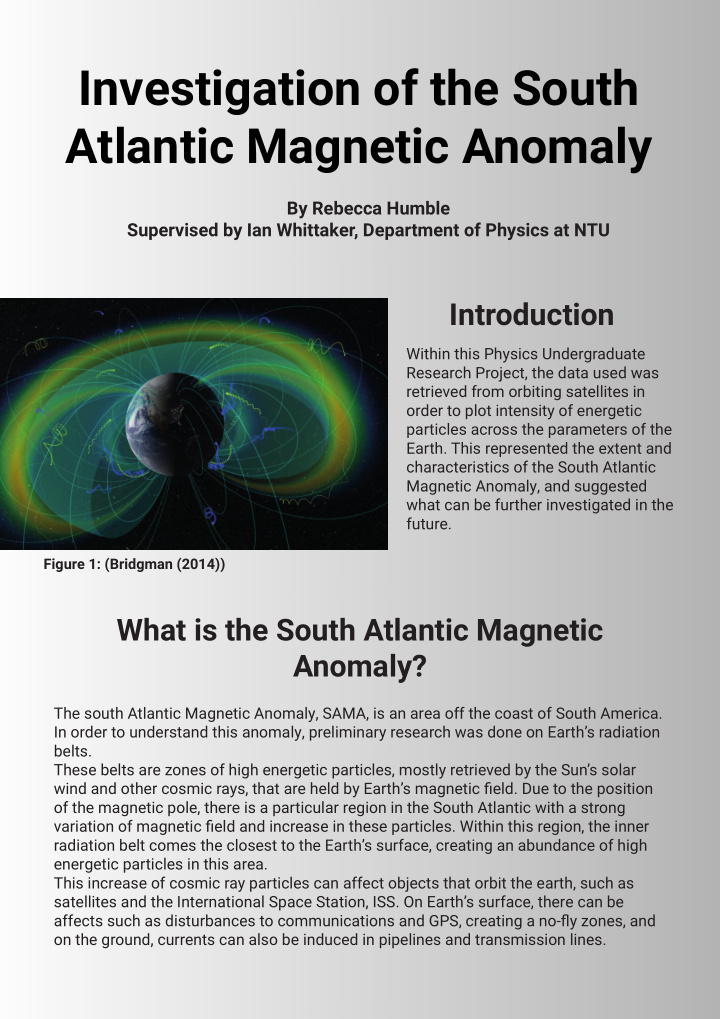



Investigation of the South Atlantic Magnetic Anomaly By Rebecca Humble Supervised by Ian Whittaker, Department of Physics at NTU Introduction Within this Physics Undergraduate Research Project, the data used was retrieved from orbiting satellites in order to plot intensity of energetic particles across the parameters of the Earth. This represented the extent and characteristics of the South Atlantic Magnetic Anomaly, and suggested what can be further investigated in the future. Figure 1: (Bridgman (2014)) What is the South Atlantic Magnetic Anomaly? The south Atlantic Magnetic Anomaly, SAMA, is an area off the coast of South America. In order to understand this anomaly, preliminary research was done on Earth’s radiation belts. These belts are zones of high energetic particles, mostly retrieved by the Sun’s solar wind and other cosmic rays, that are held by Earth’s magnetic fjeld. Due to the position of the magnetic pole, there is a particular region in the South Atlantic with a strong variation of magnetic fjeld and increase in these particles. Within this region, the inner radiation belt comes the closest to the Earth’s surface, creating an abundance of high energetic particles in this area. This increase of cosmic ray particles can affect objects that orbit the earth, such as satellites and the International Space Station, ISS. On Earth’s surface, there can be affects such as disturbances to communications and GPS, creating a no-fmy zones, and on the ground, currents can also be induced in pipelines and transmission lines.
Aims The aims of this study was to determine the size and variation of the South Atlantic Magnetic Anomaly. In order to do this, data was taken from the French DEMETER mission to produce maps of particle precipitation at different orbital periods. This involved programming data through MATLAB, a platform specifjcally designed for engineers and scientists. All the data used spans over a 5 years period, the length of the DEMETER mission. Figure 2: 2005 SAMA plot Method To visually see the SAMA, a minimum As well as a bulging area of intensity of 1-month worth of data fjles needed between 100 - 230 degrees latitude, this to analyzed and plotted. All these fjles being the SAMA, it also shows the area contained a vast amount of data, not all above the anomaly is empty of energetic of which was needed. In order to only pull particles. This is due to the particles in at out certain variables, a code was written the South Atlantic region travelling into our that could sift through the fjles, saving only upper atmosphere, and not being able to specifjc data. bounce back. This information included orbital Figure 3 shows a plot of the log_10 parameters, this being the position of average intensity over the course of a the satellite around the earth in longitude year. , which allowed for more accurate and latitude values. Next was the orbital measurements of the expanse of the time, given in Julian date, the number of anomaly, while keeping record of the size days since 1st January 4713 BC. This and variation with the changing months. then needed to be converted into modern Log 10 (Intensity) 2004 calendar days. Then fjnally, the fmux. This is the intensity of energetic particles given at over 120 wavelengths. Figure 2 is a plot of the average fmux over the course of an entire year, this specifjcally being 2005. The colour bar, set to the maximum intensity recorded by the satellite, represents the average value in each area set to a 1 degree accuracy. This representation shows the radiation belts as two sinusoidal waves at the top and bottom Figure 3: Log 10 (Intensity) 2004 of the plot.
Findings The results of the coding process were verifjed on a global scale as shown in the fjgure above, the fmuxes have values within an expected range and the general shape of the radiation belts is present. The focus of the study could then proceed to the South Atlantic Anomaly itself. The disturbance storm time index, Dst, measures geomagnetic activity, used to assess the severity of magnetic storms. Figure 4 and 6 are two graphs representing two different months worth of Dst data, October and November 2004. Figure 5 and 7 are the plots of the average fmux in each of them months. Figure 4: Oct 2004 Dst Figure 6: Nov 2004 Dst Figure 5: Oct 2004 SAMA plot Figure 7: Nov 2004 SAMA plot When the Dst value is lower than -50 nanotesla, that signifjes a geomagnetic storm, suggesting an increased fmuctuation in the magnetic fjeld. As shown in November 2004, this increases the intensity of the energetic particles not only in the region of the SAMA but also throughout the radiation belts. What you can also visually see is how the SAMA seems to have two higher intensity peaks within the region. Further Research Further research into the investigation of the SAMA could focus specifjcally on what causes this region of high energetic particles to split into two high intensity peaks. A good starting point would be focusing on the timeframes where this seems to occur in previous research, looking for possible factors which may encourage this. Furthermore, more in detail of the specifjc processes going on could be investigated, helping to prevent current affects the anomaly has on ground, in the air and in space.
Recommend
More recommend